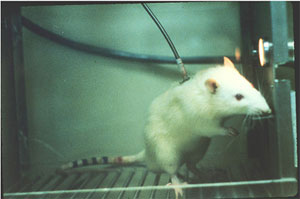NIDA-supported research has produced evidence that a medication that supplements recovering cocaine addicts' brain concentrations of the neurotransmitter glutamate may reduce their vulnerability to relapse. Although the research was done with laboratory rats, the substance used to bolster glutamate levels was acetylcysteine, a medication that is safe for humans and used routinely in emergency rooms to treat overdoses of the analgesic acetaminophen.
 A Possible Addiction Therapy, Built From the Ground Up. Training chambers like this one are used to study animals' responses to drugs. By pressing the lever, the rat obtains an infusion of a drug, a medication, or saline through the tube. Using such apparatus, NIDA scientists showed that cocaine abuse reduces brain glutamate levels, and treating animals with acetylcysteine reduces subsequent cocaine seeking.
A Possible Addiction Therapy, Built From the Ground Up. Training chambers like this one are used to study animals' responses to drugs. By pressing the lever, the rat obtains an infusion of a drug, a medication, or saline through the tube. Using such apparatus, NIDA scientists showed that cocaine abuse reduces brain glutamate levels, and treating animals with acetylcysteine reduces subsequent cocaine seeking.Dr. Peter Kalivas and colleagues at the Medical University of South Carolina in Charleston measured the glutamate concentrations in the fluid surrounding the cells in rats' nucleus accumbens (NAc) in the absence of cocaine exposure; after training the animals to voluntarily self-administer the drug by pressing a lever in their cage; and 3 weeks after removing the animals' access to cocaine. Compared with the concentrations in nonexposed animals, those during cocaine self-administration were markedly higher, and those after forced abstinence markedly lower. The investigators concluded that rats repeatedly exposed to cocaine develop glutamate concentration deficits in the NAc that persist for a considerable time after access to the drug is removed.
Dr. Kalivas and colleagues next investigated whether cocaine or acetylcysteine would restore the rats' glutamate levels and the effect on the animals' motivation to self-administer cocaine. As in their first trials, the researchers began by training rats to press a lever to obtain cocaine, then removed the cocaine from the solution the rats received when they pressed the lever. As before, these procedures left the rats with reduced NAc glutamate concentrations; the rats also lost interest in pressing the lever because it no longer delivered cocaine. At this point the researchers injected some of the animals with a single dose of cocaine and others with a dose of acetylcysteine followed by a dose of cocaine. The initial cocaine and acetylcysteine doses both increased glutamate to the elevated levels that followed cocaine self-administration. However, the rats given only cocaine resumed drug-seeking behavior—they began pressing the lever to try to self-administer cocaine—while those given acetylcysteine prior to cocaine did not.
"Restoration of glutamate by acetylcysteine blocked reinstatement of drug seeking in rats trained to self-administer cocaine," Dr. Kalivas says. "This strongly indicates that susceptibility to relapse is due in part to diminished levels of extracellular glutamate associated with drug withdrawal. Our finding could well apply to people, too, since self-administration and reinstatement in animals are reliable models of addiction and relapse in humans."
Dr. Kalivas' findings add to a growing of information describing glutamate's important role in the neurobiological processes underlying drug abuse and addiction. Glutamate is a neurotransmitter, a chemical that acts as a messenger between brain cells. NIDA investigators have lately focused attention on glutamate in part because it influences levels of another neurotransmitter, dopamine, in the brain's pleasure center, the NAc. Fluctuations in NAc dopamine levels underlie the euphoria of initial drug use and contribute to other aspects of cocaine and other drug abuse and addiction. Glutamate signals also amplify the addictive effects of nicotine (see "Nicotine's Multiple Effects on the Brain's Reward System Drive Addiction," NIDA NOTES, Vol. 17, No. 6), and contribute to a condition called "long-term potentiation," which causes brain cells that have been exposed to addictive drugs to release dopamine more abundantly in response to subsequent exposure (see "Addictive Drugs and Stress Trigger Similar Change in Brain Cells, Animal Study Finds," NIDA NOTES, Vol. 18, No. 5).
The scientists' successful use of acetylcysteine to restore normal glutamate levels supports their hypothesis that cocaine reduces glutamate concentrations in the fluid surrounding cells in the NAc. They suspect that repeated drug exposure followed by drug withdrawal disrupts a process known as cystine-glutamate exchange: molecules of cystine enter NAc nerve cells, which pump molecules of glutamate out in exchange. The exchange normally maintains appropriate concentrations of both chemicals inside and outside the cells, but disruption by drugs may result in a shortage of extracellular glutamate. The researchers speculate that acetylcysteine rectifies this shortage because it forms cystine molecules when it is metabolized. These molecules then enter the cells and prompt them to pump out additional glutamate.
Dr. Nancy S. Pilotte of NIDA's Division of Neuroscience and Behavioral Research says Dr. Kalivas's glutamate research demonstrates the value of moving beyond studies that focus on the dopamine-triggered pleasure associated with abuse and addiction. "We need to move on from thinking of dopamine as the center of the universe," she says, adding that the payoff for broader research perspectives may be "more molecular targets for development of medications."
Following up on the results of his animal studies, Dr. Kalivas has begun a clinical trial to determine whether acetylcysteine can control substance abuse patients' craving for cocaine once they have achieved abstinence. He and his colleagues are also conducting further laboratory studies to evaluate whether the compound may prevent animals from seeking opioids or alcohol as effectively as it prevents them from seeking cocaine.
Source
- Baker, D.A.; McFarland, K.; Lake, R.W.; Shen, H.; Tang, X.C.; Toda, S.; and Kalivas, P.W. Neuroadaptations in cystine-glutamate exchange underlie cocaine relapse. Nature Neuroscience 6(7):743-749, 2003. [Abstract]
